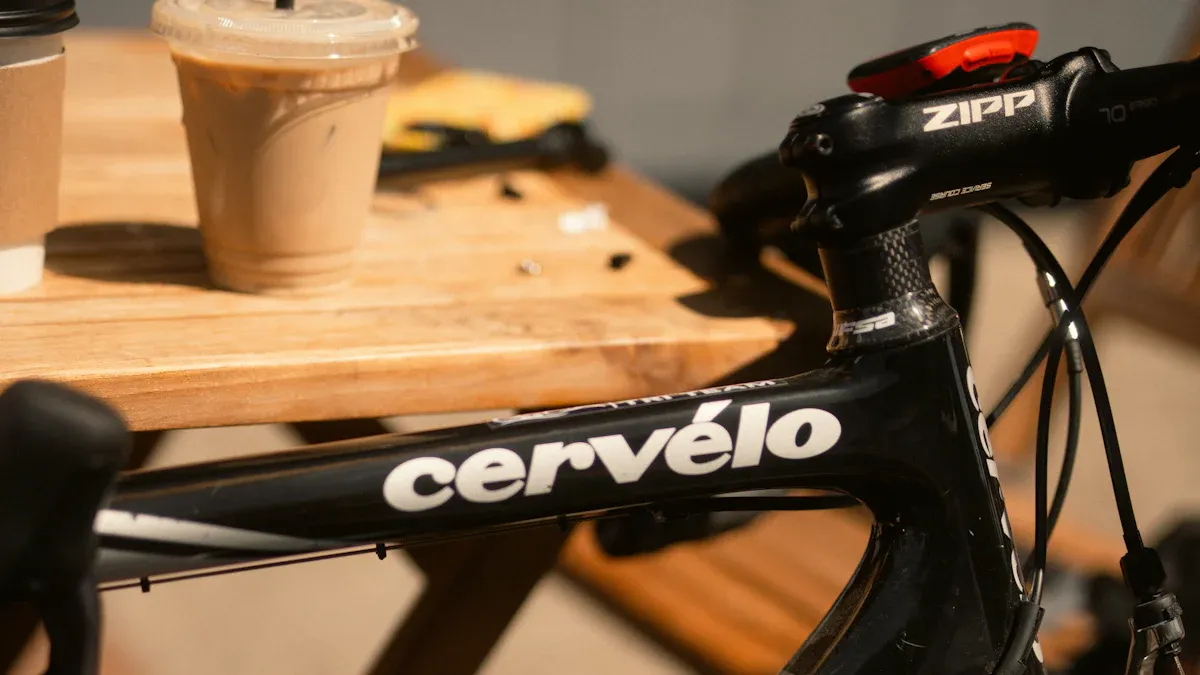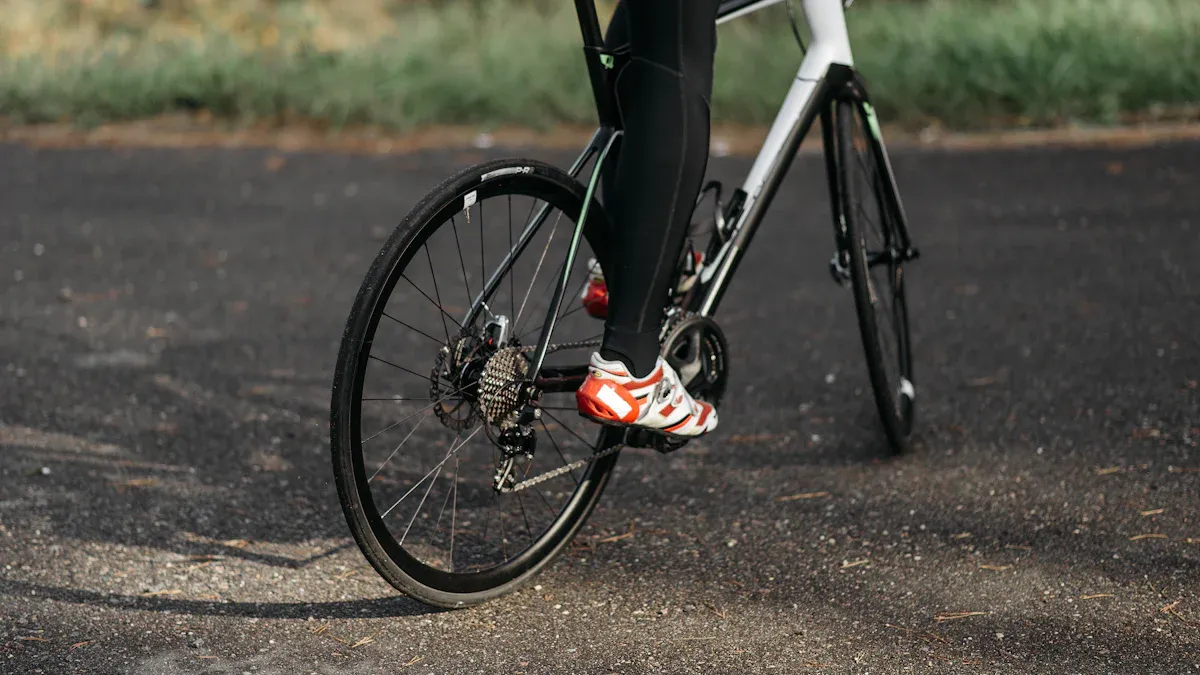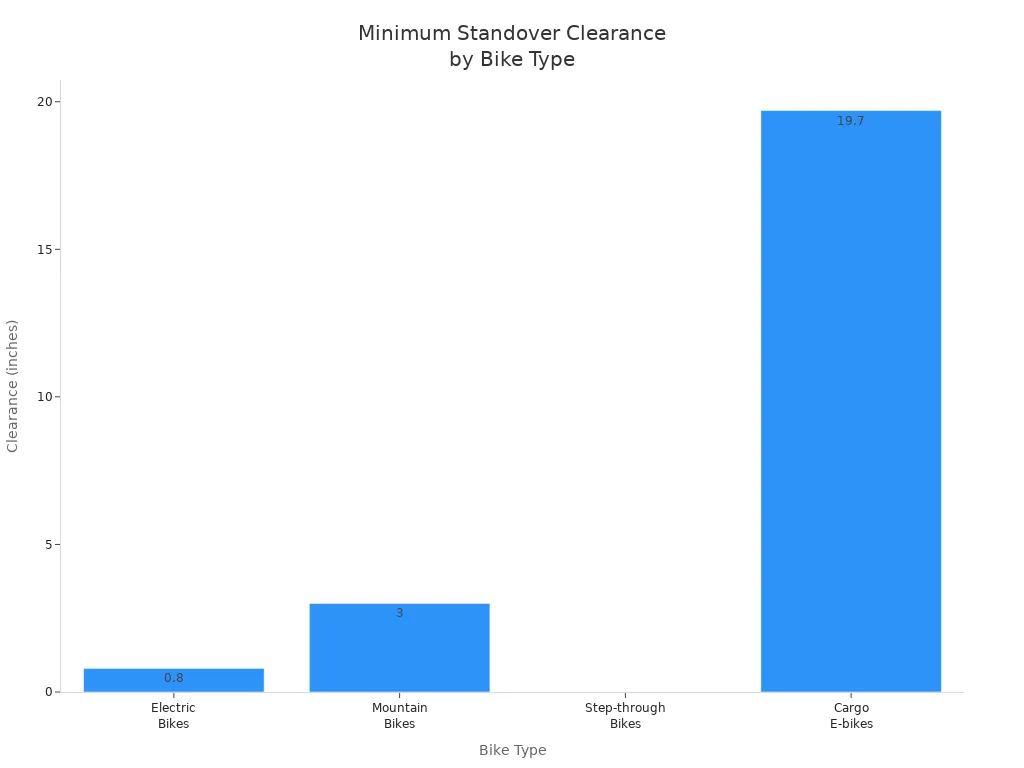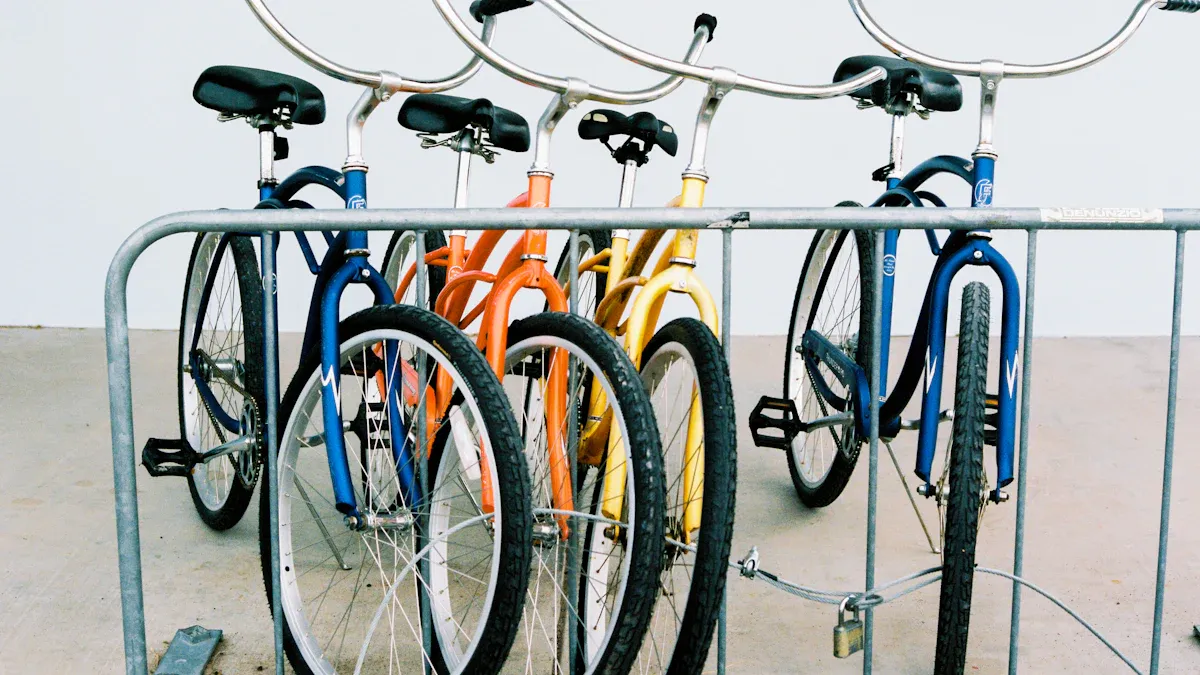
Ever tried riding a bike that just feels wrong? Maybe your knees bump the handlebars, or you stretch too far to reach them. Picking the right size means you get comfort, control, and better performance every time you ride. Your body measurements help you find the perfect size. The size of your bike matters for every ride. You need to look at the size of the frame, the size of the wheels, and the size of the seat. Think about your riding style and where you want to go. Your hip size, arm size, and leg size change how a bike fits. Before you check any size chart, remember that a bike frame comparison starts with your unique needs and size.
Key Takeaways
Check your height and inseam to get the right bike size for you. – Look at bike size charts first, but always try the bike. Think about how you ride and your body shape too. – Pick a bike frame that gives you enough space to stand over it. This helps you stay safe and feel good when you get on or stop. – Change your bike’s seat, handlebars, and stem after you pick the frame size. This will help you feel better and ride easier. – You can get a pro bike fitting for the best comfort and to stop injuries. This is extra helpful if you ride a lot.
Bike Size Guide

Choosing the right bike starts with knowing your measurements. This bike size guide will help you figure out what you need for a comfortable and safe ride.
Measurements
You might wonder, “How do you figure out your bike size?” It all begins with a few simple measurements. Here’s what you need to know:
Height: Stand barefoot against a wall. Measure from the floor to the top of your head. This is the first step in sizing.
Cycling Inseam: Stand with your feet apart. Place a large book between your legs, like you’re sitting on a bike saddle. Measure from the top of the book to the floor. This inseam is different from your pants inseam and is super important for bike sizing.
Arm Length (Wingspan): Stretch your arms out wide. Measure from fingertip to fingertip. This helps if you’re between sizes or want to check your reach.
Standover Height: This is the space between the top tube of the bike and your crotch when you stand over the frame. You want at least 2 cm (about 1 inch) for comfort and safety.
Tip: Height and inseam are the two main numbers you need for most bike sizing charts. Arm length and standover height help you fine-tune your fit.
Stand-Over Clearance
Standover clearance is all about safety and comfort. If you have enough space between your body and the bike’s top tube, you can hop on and off easily. Not enough clearance? You risk bumping yourself or falling.
Here’s a quick look at how much standover clearance you need for different bikes:
Bike Type | Recommended Minimum Standover Clearance | Why It Matters |
|---|---|---|
Road/Hybrid Bikes | At least 1 inch (2.5 cm) | Lets you stop and stand safely without hitting the frame. |
Mountain Bikes | 2-4 inches (5-10 cm) | More clearance helps you get off quickly on rough trails. |
Electric Bikes | At least 2 cm (0.8 inches) | Heavier bikes need extra space for safe stops. |
Step-through Bikes | Very low standover height | Easy to mount and dismount, great for shorter riders or frequent stops. |

Matching your inseam to the standover height is key. If you ride a mountain bike, you want more clearance because you might need to jump off fast. For road bikes, a little less is okay since you ride mostly on smooth surfaces. Always check the standover height before you buy.
Sizing Formulas
Sizing formulas give you a quick way to estimate your frame size. They use your inseam and a multiplication factor based on the type of bike. Here’s how it works:
Mountain Bike: Inseam (cm) × 0.57 = Frame size (cm)
Trekking Bike: Inseam (cm) × 0.63 = Frame size (cm)
Road Bike: Inseam (cm) × 0.66 = Frame size (cm)
For example, if your inseam is 80 cm:
Mountain bike: 80 × 0.57 = 45.6 cm
Trekking bike: 80 × 0.63 = 50.4 cm
Road bike: 80 × 0.66 = 52.8 cm
Note: These formulas are a starting point. They don’t replace a test ride or a professional fitting. Brands and models can fit differently, so always double-check.
Adult bike sizing uses these formulas for both men and women. Kids’ bikes use wheel size instead of frame size because their frames are much smaller.
Category | Sizing Method | Notes |
|---|---|---|
Frame size (inches or standard sizes) | Use same size charts; sizing based on leg inseam or height; formulas like inseam × 0.57 (mountain) or × 0.66 (road) apply | |
Children (under 12) | Wheel size (inches) | Frames are very small; wheel size increments represent bigger size steps; sizing by wheel diameter |
Why Body Proportions Matter
Your body isn’t just about height and inseam. Torso length, arm length, and hip mobility all play a part in sizing. If you have long legs and a short torso, you might need a different frame than someone with the same height but different proportions. Long arms make it easier to reach the handlebars. If you’re flexible, you can ride a more aggressive position. If not, you’ll want a more upright fit.
Tip: Hip mobility affects how low you can bend on the bike. If you have tight hips, pick a frame that lets you sit more upright. If you’re flexible, you can go for a lower, faster position.
Everyone’s body is different. That’s why the best bike size guide always recommends trying bikes in person or getting a professional fitting. Sizing charts and formulas help, but your comfort and control matter most.
What Size Bike Should I Get
Choosing the right bike can feel confusing. You see so many numbers, charts, and labels. You might ask yourself, “What size bike should I get?” Let’s break it down so you can make a smart choice.
Using Size Charts
Size charts are a great place to start. Most brands offer their own sizing guides. Some use numbers like 48 to 62 cm, while others use simple labels like XS to XL. There’s no universal standard for measuring frame size. A size 56 from one brand might fit differently than a size 56 from another. This happens because manufacturers use different ways to measure seat tube length, reach, and stack. Racing bikes have longer reach and lower stack for speed. Gravel bikes have shorter reach and higher stack for comfort. Mountain bikes use wheel size and frame geometry to match terrain and riding style. Kids’ bikes use wheel size and age instead of frame measurements.
Important info about bike size charts: Always check the chart for your chosen brand. Compare your height and inseam to their recommendations. Try to look at reach and stack numbers if you want a more precise fit. Sizing charts help you narrow down your options, but you need to test ride or adjust the bike to see if it feels right.
Brand | Sizing Label | Measurement Type | Notes |
|---|---|---|---|
Trek | 52, 54, 56 | Seat tube length | May differ from other brands |
Giant | S, M, L, XL | Height range | Uses reach and stack for fit |
Specialized | 49, 52, 54 | Seat tube length | Check geometry for riding style |
You should always use sizing charts as a starting point. Your height and inseam matter most, but your body proportions and riding style also play a big role.
Between Sizes
Sometimes you fall between two sizes. Maybe your height and inseam put you right in the middle. You wonder when to size up or down. Here’s what you need to know:
If you’re between sizes, most experts suggest sizing down. Smaller frames feel more playful and easier to handle. You can adjust the seat post and handlebars to make a smaller bike fit better. This works well for riders who want quick handling or ride on tight trails.
Larger frames offer more stability, especially at high speeds or on rough terrain. They feel more balanced and confident. But if you choose a bigger size, you might find it harder to maneuver in tight spots. Adjusting a larger frame to fit a smaller rider can mess with the bike’s geometry and handling.
Sizing down gives you more options for adjustment. You can raise the seat and use a longer stem. Sizing up limits your ability to make the bike smaller. Always test ride both sizes if you can. See which one feels better for your riding style and terrain.
Tip: When to size up or down depends on your comfort, skill level, and where you ride. If you like fast descents and rough trails, a bigger frame might suit you. If you prefer technical climbs and quick turns, go smaller.
Professional Fitting
You might wonder how to check if a bike is the right size. A professional fitting can help you answer that question. Bike shops offer fitting services that use advanced tools like motion capture and pressure mapping. Fitters look at your body mechanics, flexibility, injury history, and riding goals.
Professional fitting improves comfort by spreading your weight evenly. You avoid pressure points and numbness. Your joints and muscles feel better.
You get better performance. Pedaling feels easier. You use less energy and go faster. Aerodynamics improve, and you feel less tired.
Fitters help prevent injuries. They spot misalignments that cause pain or strain. Small changes in saddle height or handlebar reach can make a big difference.
DIY sizing helps with basic adjustments, but it misses subtle problems. Professional fitting finds the best position for your body and riding style.
Note: Riders with chronic pain or those who want top performance benefit most from professional fitting. Even small tweaks can boost comfort and power.
If you want the best fit, visit a bike shop for a personalized fitting. You’ll get expert advice and leave with a bike that feels perfect for your body.
Type of Bike

When you choose a bike, you need to think about the type of bike that fits your needs. Each type of bike has its own frame geometry, which affects how the bike feels and what size works best for you. Let’s look at the main bike categories and see how they compare.
Road vs. Mountain
Road bikes and mountain bikes have very different designs. Road bikes use a lightweight frame and a more aggressive riding position. This helps you go fast on smooth pavement. Mountain bikes have a sturdy frame and an upright position. This gives you better control on rough trails. The size of the frame changes how each bike handles.
Here’s a quick table to show the main differences:
Geometry Aspect | Road Bikes | Mountain Bikes |
|---|---|---|
Head Tube Angle | Steep (quick steering) | Slack (stable on rough terrain) |
Bottom Bracket Height | Low (efficient pedaling) | High (avoids pedal strikes) |
Wheelbase | Short (agile) | Long (stable) |
Riding Position | Aerodynamic | Upright |
Frame Robustness | Lightweight | Sturdy |
You need to match the size of the frame to your body and the type of bike you want. A road bike in your size will feel very different from a mountain bike in the same size.
Hybrid and Others
Hybrid bikes mix features from both road and mountain bikes. They give you a comfortable, upright position and medium-width tires. This makes them great for city streets and light trails. Most hybrids have flat handlebars for easy control and a wide range of gears. You can find options with disc brakes for safe stopping in any weather. Many hybrid frames have mounts for racks and fenders, so you can carry bags or ride in the rain.
Other bike categories include step-through frames, which are easy to get on and off. These work well for commuting or casual rides. When you choose a bike, look at the size chart for each type. Hybrids and step-through bikes often have their own sizing rules.
Intended Use
Think about where you plan to ride. If you want to commute in the city, a step-through frame makes mounting easy and keeps you comfortable. For off-road adventures, a step-over frame gives you more control and power. The size of your bike should match your riding style and the surfaces you ride on. Some options work better for hills, while others are best for flat roads.
Tip: Always test ride different bike categories before you decide. The right size and type of bike will make every ride more fun and comfortable.
Fit
Riding Position
Your riding position changes everything about how your bike feels. If you want to ride fast, you might choose a frame with a lower handlebar and a longer reach. This puts you in a more aerodynamic position. For comfort, you may want a more upright position with a shorter reach. The geometry of your bike frame, like the angle of the seat tube or the length of the top tube, shapes your posture. For example, time trial bikes have a steeper seat tube angle and a shorter top tube. This helps you stay low and fast while keeping your hips open for better breathing and muscle use. Road bikes use a balance between comfort and speed, while mountain bikes give you an upright position for control on rough trails. The right size and geometry help you find the best fit for your style.
Comfort and Control
A good fit means you feel comfortable and in control every time you ride. If your bike is too big or too small, you might feel stretched out or cramped. You want your knees to bend just right at the bottom of each pedal stroke. Your hands should rest easily on the handlebars. When you have the proper bike fit, you avoid pain and ride longer without getting tired. Comfort and control also depend on your riding position. If you sit too low or too high, you can lose power or hurt your back. Always check your size and fit before you ride.
Tip: A comfortable fit boosts your confidence and helps you handle your bike better, especially on tricky roads or trails.
Adjustments
You can fine-tune your fit with a few simple adjustments. Start by checking your saddle height. Your knee should stay slightly bent when your foot is at the bottom of the pedal stroke. Move your saddle forward or backward to line up your knee with the pedal axle. Adjust your stem length to change your reach. If you feel too stretched, try a shorter stem. If you feel cramped, use a longer one. Handlebar width should match your shoulders for better breathing and control. Small changes in these parts can help you get the right size and fit, even if your frame is not perfect. Adjustable components like stems and handlebars let you fix minor size issues, but they cannot replace a frame that is way too big or too small. Always make changes slowly and test your fit after each adjustment.
Bike Frame Comparison
When you look at a bike frame comparison, you see that not all frames are the same. The material, geometry, and price can change how your bike feels and how much you enjoy your ride. Let’s break down what matters most when you compare frames.
Frame Materials
You have three main choices for frame materials: aluminum, carbon, and steel. Each one gives you a different ride experience.
Aluminum frames are light and stiff. They help you transfer power to the pedals, but you might feel more bumps on rough roads. Aluminum is tough and shows dents if you hit something, which can warn you about damage. These frames usually cost less and work well for many riders.
Carbon frames feel smooth and fast. They soak up road vibrations, so your hands and feet stay comfortable. Carbon frames are very light and strong, but they can hide cracks inside after a hard hit. You need to check them often. Carbon frames cost more, but they last a long time if you take care of them.
Steel frames are heavier, but they give you a soft, comfortable ride. Steel lasts for years and can handle rough use. Many riders like steel for its classic feel and strong build.
Here’s a quick table for your bike frame comparison:
Material | Weight | Ride Quality | Durability | Cost |
|---|---|---|---|---|
Aluminum | Light | Stiff, less comfy | Good, shows dents | Low-Medium |
Carbon | Very light | Smooth, responsive | Needs inspection | High |
Steel | Heavy | Very comfy | Excellent | Low-Medium |
Geometry Differences
The geometry of your bike frame changes how you sit and how the bike handles. When you do a bike frame comparison, look at the shape and angles of the frame.
Endurance bikes have a taller front and a shorter reach. You sit more upright, which feels better on long rides.
Racing bikes have a lower front and a longer reach. You lean forward, which helps you go faster but can feel less comfy.
Geometry Aspect | Endurance Bike | Racing Bike |
|---|---|---|
Rider Position | Upright | Low, stretched out |
Handling | Stable, smooth | Quick, sharp |
The right geometry helps you find the best size and fit for your riding style.
Budget and Upgrades
When you start your bike frame comparison, think about your budget. Entry-level frames cost less than $2,000. These frames use aluminum or basic carbon. They are heavier and may not feel as smooth. High-end frames can cost $8,000 or more. They use top-quality carbon and special shapes for better speed and comfort.
You can upgrade parts like wheels and gears later, but you cannot change the frame size or material. If you want to improve your bike over time, start with the best frame you can afford. Pick the right size now, and you can make your bike even better as you go.
Tip: The frame is the heart of your bike. Choose wisely, and you’ll enjoy every ride!
Choosing the right bike frame starts with accurate measurements. Follow these steps for the best results:
Check the size of the frame using a chart for your bike type.
Think about your body shape and riding style.
Test ride bikes to see how each size feels.
Many riders make mistakes by picking a size based only on standover height or past bikes. You want a frame that matches your needs, not just what is on sale. A professional fitting helps you avoid pain and boosts your power. The right size gives you control, comfort, and confidence every time you ride. The bike-buying process feels easier when you focus on fit and comfort, not just numbers. Start your search today and enjoy every ride with the perfect size for you!
FAQ
What if my height and inseam put me between two bike sizes?
You should try both sizes if possible. A smaller frame gives you more control and easier handling. You can adjust the seat and handlebars for comfort. Test rides help you find the best fit.
Do different bike types use different sizing charts?
Yes, each bike type uses its own sizing chart. Road bikes, mountain bikes, and hybrids all measure frames differently. Always check the chart for your chosen bike. This helps you avoid confusion with bike sizing faqs.
Can I change my bike fit after buying?
You can make small changes. Adjust the saddle height, stem length, and handlebar position. These tweaks improve comfort and control. If the frame is too big or too small, you may need a different bike.
How important is standover clearance for safety?
Standover clearance keeps you safe when you stop or get off your bike. You want at least 2 cm between you and the top tube. This tip appears often in bike size faqs because it prevents injuries.
Should I get a professional bike fitting?
A professional fitting helps you ride longer and feel better. Experts use tools to match your bike to your body. You avoid pain and improve performance. Many riders say it is worth the time and cost.
See Also
How To Find The Perfect Bike Frame For You
Selecting The Ideal Step Through Bike Frame For You
Pro Tips For Picking The Best Carbon Mountain Bike Frame
